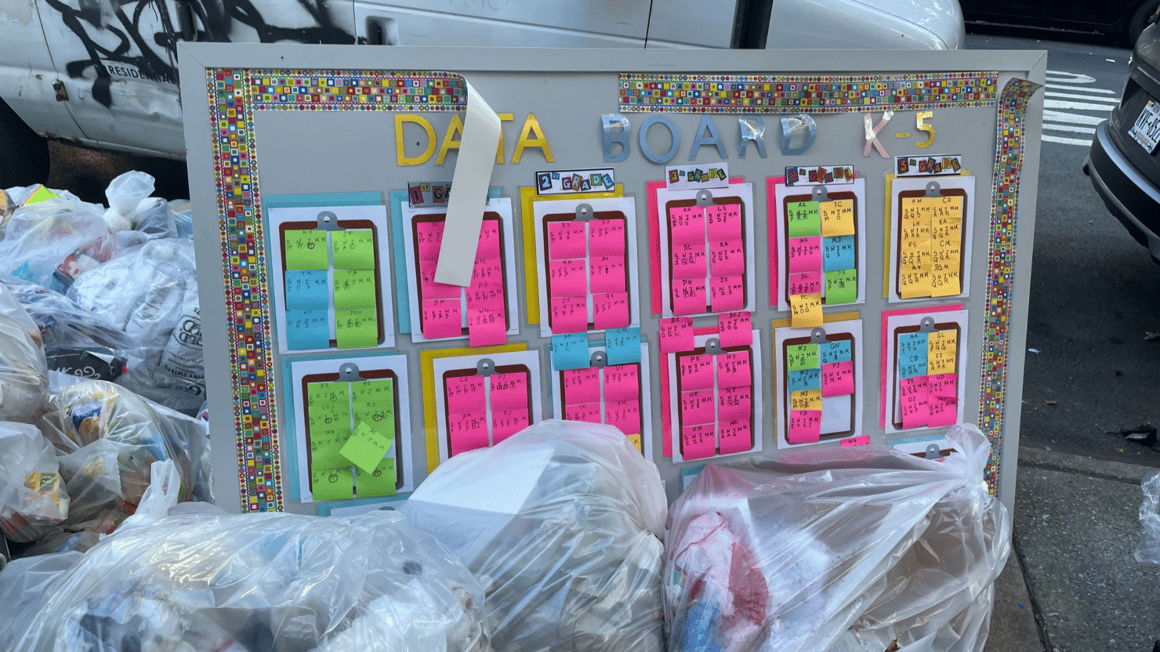

Published: September 20, 2022
You can spot one a mile away. It's easily recognizable in schools across the country and even globally. It will become an artifact of the first two decades of the 20th century.
I'm talking, of course, about The Data Wall.
And when I say “Data Wall” I trust you know exactly what I’m talking about. You may have even created one, maintained one, contributed to one, or tried to interpret one.
The Data Wall was a natural phenomenon, and we have No Child Left Behind to thank. This legislation brought a new intensity on measuring student achievement. As such, NCLB encouraged teachers and school leaders to visualize student academic growth in a new way.
But criticism of Data Walls has been steady over the past decade. And now, the time has officially come for The Data Wall to become a thing of the past.
What defines a Data Wall?
The Data Wall is a clever and crafty method of showing student academic achievement. Teachers across classes and even grades want to review and reflect on student progress. After all, that's a key component of data-driven instruction. And other building staff—like admins, literacy coordinators, paraprofessionals, special educators, and instructional coaches—need learning data to make school decisions as well. A quick search for Data Walls on Teachers Pay Teachers returns tens of thousands of accessible resources. This indicates Data Walls are still incredibly popular in schools.
Data Walls typically take the form of a graph or chart. Levels of mastery or achievement are on one axis and students’ grade levels on the other. Some Data Walls take up a single bulletin board, others an entire wall or even room. The chart or graph represents each student's academic performance. Some schools feature all students, others only those in tested grades/subjects.
And there is usually a clear focus on two distinct types of learners.
First, the students most behind grade-level expectations and with the most to catch up. These are often the students that need the most intervention and support.
Second, the students that may be JUST on the cusp of performing at or above grade level. Under NCLB, if a school could be deemed struggling. If so, it was critical to move these scores to make the Adequate Yearly Progress distinction.
Dated Data on the Wall
When Data Walls first gained popularity, teachers had limited student performance data to chart. Often, the Data Wall shows each student progressing along on an interim assessment program—like NWEA’s MAP Growth assessment. While these assessments are important measures of periodic student performance, they are typically administered infrequently; 3 times per school year.
This means that interim assessment scores on a Data Wall are quickly outdated, since students learn and grow every day. Therefore, teachers make decisions about students and their abilities using stale data—not exactly the data culture we want to cultivate.
Taking Data from Digital to Analog
Most of the data on a Data Wall originally came from a digital source, and then was converted to analog. This happens by printing student scores, writing them down, or even translating them. Common translation in Data Walls are a code, color, sticker, or other signifier.
This data copying takes an incredible amount of time for already-strapped teachers. What’s worse, instructional systems cannot make use of analog data. That hinders important instructional decisions for students. For teachers to get the most out of student data, it should be as interoperable as possible.
Data walls that feature time-consuming, analog, stale data just aren’t as useful to teachers today as they used to be.
And then there’s the security problem…
One of the biggest reasons to ditch your data wall is that they have the potential to be huge violations of student privacy. Important information like student performance should be thoughtfully protected and accessible to staff only—not shared with the entire school, and especially not to the entire student body. This potential for shame or humiliation is especially damaging for the students that already struggle academically.
With this in mind, data wall creators get crafty. One of two things typically happens on Data Walls as an attempt to protect student privacy and security…
- Teachers deploy a very breakable code to “conceal” student identities in an attempt to shield them from other students knowing their performance. Think using initials or students’ ID numbers on the visible charts. The problem is, kids are perceptive and often more clever than we give them credit for. Students know who in the class routinely learns new concepts easily and who frequently struggles. This foils any attempt to keep student performance on the data wall a secret.
- The other route teachers pursue is to create a coding system so cryptic, so mysterious that no student could possibly crack it. This often impacts the easy-to-glance visual nature of data walls. The problem here, though, is that such obfuscation renders the data almost meaningless. As such teachers can’t make heads or tails of the Data Wall, which pretty much defeats its purpose.
Ideally, schools should password-protect student progress and performance data, making it accessible only by those with proper credentials and authority. This includes staff and faculty and administration of course, but even students themselves and their parents and guardians. With so many technologies today having the ability to give students access to their own learning results, allowing them to participate in their own data feedback loop might help motivate them to succeed.
There’s a new data landscape out there
Gone are the days of thousands of copies per week, of overhead projectors and interdepartmental mail, of printouts of student assessment scores. With the steady transition to digital providers of instructional tools AND assessments, taking data from a digital format and converting it into an analog one for a Data Wall just doesn't make sense anymore.
Modern data systems allow schools and teachers to create digital versions of data walls using real-time, live student progress data. That means every teacher can have the most current snapshot of what students know and can do at any time in a safe, secure dashboard. These also allow teachers to drill down into individual students, assignments, trends, date ranges, and student groups or cohorts.
These systems—called Student Data Platforms—gather learning data safely from all types of sources. Student Data Platforms can pull information directly from LMS assignments and turn that into usable data—like homework completion rates, grades and scores, and even late or missing assignments percentages.
They can also bring in data from the diagnostic, formative, interim, and summative assessment providers that a school or district uses with students. They can often house data from annual state tests, and even sync with demographic data from your SIS. Schools can then see a year-long picture of student attendance, engagement, and performance against learning standards.
When teachers have all this data about each of their students, connected and accessible and easy to visualize, they can make important instructional decisions that actually move students forward each and every day.
Schools need a Student Data Platform, not a Data Wall
With the intense focus these days on protecting student data, it's clear that data walls have to go. They just don't do a satisfactory job keeping student learning data secure.
Schools should provide their staff a data solution that protects student privacy, giving access to a student’s academic data only to those who need it, and keeping access from those who don’t. These platforms should also bring together multiple types of data that accurately reflect the complex, nuanced learning journey of each child, rather than over-indexing on one measure of student progress.
However, schools should continue to root much of their staff conversations, grade level meetings, and PLCs’ time to reviewing student progress and planning thoughtful interventions and adjustments. This emphasis on teaching collaboratively was one of the most beneficial outcomes of the Data Wall phenomenon. This trend should continue long after they’re taken down.
And finally, schools must help teachers prioritize the growth of every single student, not just the “bubble kids”. Students performing above grade will never be moved forward along a data wall because there’s nowhere left to go, but their growth is worthy of celebration nonetheless. And students who remain well below grade level all year long can still make impressive and commendable progress, even if their sticky note never leaves the bottom left corner of the chart. Data Walls just weren’t designed to display these kinds of learning narrative.
What comes after data walls?
With all this data about student capabilities at our fingertips, we must treat it with respect. Data Walls served their purpose, but it’s a new age in schools and their time is now in the past. It’s time for schools to adopt a Student Data Platform to take their data culture to the next level.
If you’re ready to ditch your data wall for good and are looking for a Student Data Platform for your school, check out the data capabilities of Schoolytics! Our platform connects with common LMS, SIS, and Assessment data sources, combines student data for a holistic view of student progress, and is easy to access and interpret for teachers, students, administrators, and parents and guardians alike. Schools get access to real-time student data for faster interventions and better differentiation.
With dashboards this good, you won’t even miss your data wall.


